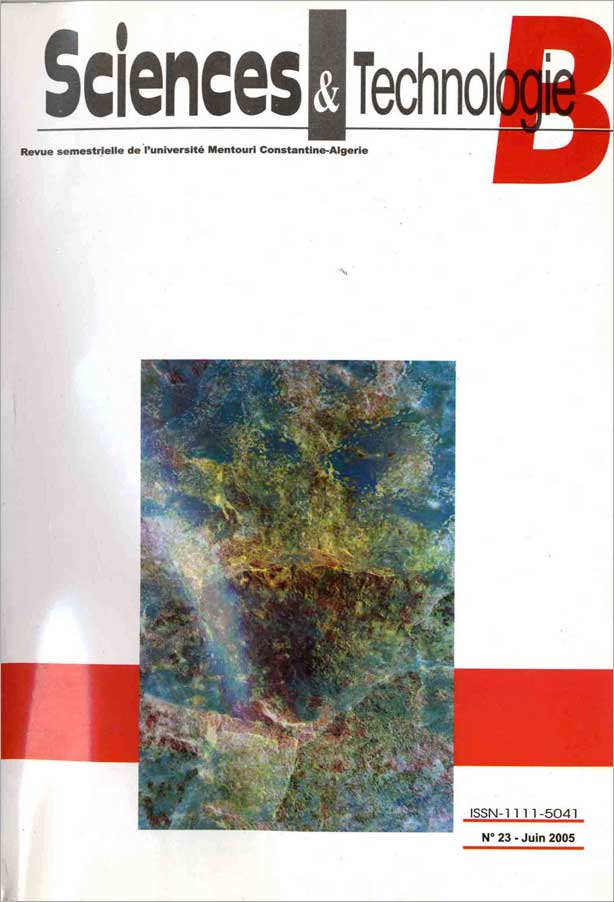ETUDE COMPARATIVE DE LA CAPACITE ADSORBANTE D’UN CHARBON ACTIF ISSU DE NOYAUX DE DATTES ET UN CHARBON ACTIF COMMERCIAL
الكلمات المفتاحية:
Head losses، Frictional head losses، Minor head losses، Singular head losses، Water distribution network، Charbon actif، adsorption، noyaux de dattes، demande biologique en oxygène، phénol، demande chimique en oxygèneالملخص
With the rise and the development ofthe industrial sector, the problem of pollution remains the subject of interest of many scientists, since it touches several vital sectors. In this work, we are interested in the water
resources polluted by the chemical substances, which can cause various problems of health. As an example, the phenols constitute an important source of pollution, and are primarily the result of industrial discharges such as the plastics, polymers, insecticides, etc. In this context, the activated carbons are adsorbents very much used industrially for the elimination of the undesirable compounds and gases. Our work presents a double environmental aspect, on the one hand, a valorization of under-natural products in fact the cores of dates, and on the other hand, the study of the adsorbent effectiveness of the activated carbon resulting from these cores. The local variety which was the subject of this study is "Itime" of Ouargla. The effectiveness is evaluated through parameters: DBO (Biological Demand for Oxygen), DCO (Chemical Demand for Oxygen) as well as the adsorption of phenol in aqueous medium. A comparative study with a commercial activated carbon at summer
carried out. The results obtained are interesting, and applications on other pollutants, in waste water are in hand.
المراجع
- Elena Fernandez .I, Thèse pour l’obtention du grade de
Docteur ès Sciences; Université de Granada ; Etude de la
carbonisation et l’activation de précurseurs végétaux durs et
mous, (2002), p3.
-Laila B. Khalil. Adsorption Sci. And Technol ; Vol 17,
No9, (1999).
- K.Gergova, N.Petrov, S.Eser. Carbon 32,4 (1994), 693-702.
- F.Rodriguez-Reinoso, J.M.Molina-Sabio, Perz-Lledo,
C.Prado-Burguete. Carbon 23, 1, (1985), 19-24.
-N.K.Chaney, AB. Ray and A. St John, Industrial and
engineering chemistry, 15, (1923),1244-1255.
- H.Jankowska, A.Swiatkowski,J. Choma, Active carbon,
military technical academy, Warsaw Poland TETJ Kemp,
(1991).
-RODRIGUEZ-REINOSO F. In Carbon and Coal Gasification; Figureiro, J.L.Moulijn, J.A., Eds.; NATO ASI Series E 105; Martinus Nijhoff Publishers: Dordrech, Boston, Lancaster, (1986), p 601.
-MERZOUGUI.Z. Préparation dematériaux à grand pouvoir
adsorbant par activation de dérivés lignocellulosiques. Thèse
de Magister à l’U.S.T.H.B (1996), Alger, p 8-9.
-SAMANNI.L-Vaute, J.L.FANLO et al. Elimination de
l’ammoniac sur divers adsorbants(charbons actifs, tourbe et
boues de station d’épuration). J, Pollution atmosphérique,
(1993).
-Compendium de Normes ISO. Qualité de l'eau, Tome 2;
Méthode chimique première édition; ISO 6060 (1989).
-AYELE. J, FABRE. B, MAZET. M., Revue des Sciences de
l’eau, 6, (1993),381-394.
- FRANK. N. KEMMER. Manuel de l’eau, Technique &
Documentation-Lavoiser, (1984), p71.
-PURI.B.R, Chemistry and Physis of Carbon .Walker,P.L,Jr.,Ed.Vol.6,P.191. Marcel Dekker, NEW YORK (1970).
-KIRK-OTHMER. Encyclopedia of chemical technology.
New York, John Wiley and sons,(1982), Vol 17, pp 373-384.
- NIOSH/OSHA, Occupational health guideline for Phenol.
Cincinnati, (1978).
- Data sheet 405. Phenol. Chicago, National Safety Council, (1970).
التنزيلات
منشور
كيفية الاقتباس
إصدار
القسم
الرخصة
Les auteurs publiant dans cette revue acceptent les termes suivants :- Les auteurs détiennent le droit d'auteurs et accordent à la revue
le droit de première publication, avec l’ouvrage disponible simultanément [SPÉCIFIER LA PÉRIODE DE TEMPS] après publication, sous la licence Licence d’attribution Creative Commons qui permet à d'autres de partager l'ouvrage en en reconnaissant la paternité et la publication initiale dans cette revue. - Les auteurs peuvent conclure des ententes contractuelles additionnelles et séparées pour la diffusion non exclusive de la version imprimée de l'ouvrage par la revue (par ex., le dépôt institutionnel ou la publication dans un livre), accompagné d'une mention reconnaissant sa publication initiale dans cette revue.
- Les auteurs ont le droit et sont encouragés à publier leur ouvrage en ligne (par ex., dans un dépôt institutionnel ou sur le site Web d'une institution) avant et pendant le processus de soumission, car cela peut mener à des échanges fructueux ainsi qu'à un nombre plus important, plus rapidement, de références à l’ouvrage publié (Consulter The Effect of Open Access).

